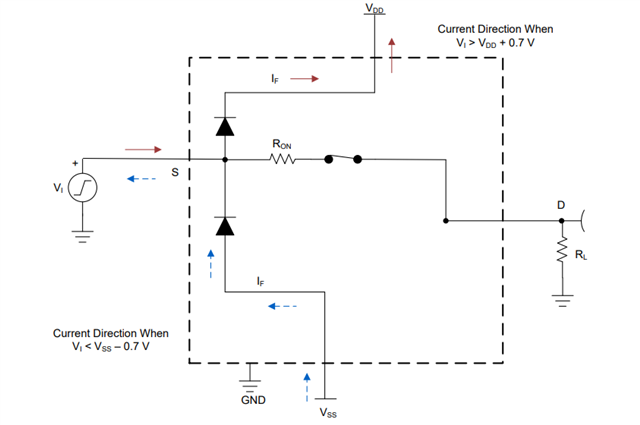While all TI switches and multiplexers incorporate some type of ESD protection, the way they are implemented can differ significantly. The typical implementation can be seen below (simplified model):

In this common topology, there are ESD diodes from input/output to VDD and diodes from input/output to VSS/GND. The way these ESD diodes normally operate is that when there is an ESD event (usually of high voltage and short duration), the ESD diodes will forward bias and divert the current through these paths and prevent damage to the internal circuity of the device itself. It is important to note that these ESD diodes are usually only suitable for protection for a very short amount of time (i.e. an ESD event).
Though these diodes are mainly used to serve that purpose of protecting against ESD events, they need to be properly accounted for in designs where there could be instances of overvoltage events. If the overvoltage event is not short in duration and lingers for an extended amount of time, this can cause irreversible damage to the device as they are not rated to sustain such long events. Take the below as an example:

When the input voltage exceeds the supply voltage by ~0.5-0.7V or is below GND/VSS by ~0.5-0.7V, this will trigger the ESD diode to conduct and shunt current to the supply or to GND. If this current is not properly controlled and below the rated diode current often found in the datasheet (can be called in the datasheet as IK, IOK, IIK) it will damage the device. Lastly, some devices may not have symmetrical diode structures. In the case of the SN74CB3Q3345, this device only has an ESD diode from the input/output to the GND pin while the input/output to VDD incorporates a powered off protection architecture (more on this below).
While the above is the most common implementation of ESD protection in many multiplexer designs, some multiplexers eliminate the possibility of having such an overvoltage event from damaging the device. Several TI multiplexers have features called powered-off protection or overvoltage protection which allows the device to see a voltage above the supply and will not trigger the ESD protection to conduct current. A quick way to determine if the device incorporates internal ESD diodes or has an overvoltage protection architecture is by simply checking the absolute maximum table to see if the signal path voltage is dependent on VDD/VSS or not:


